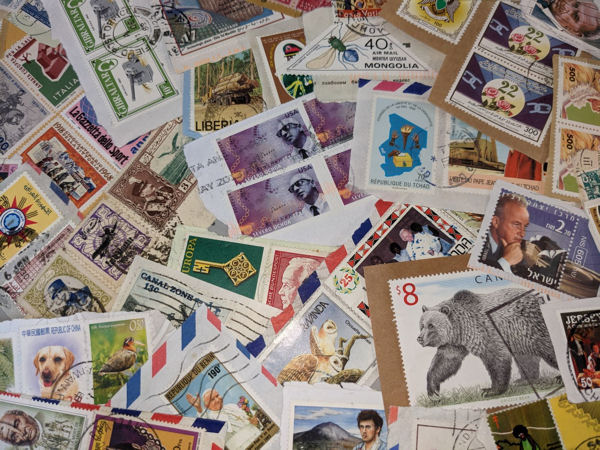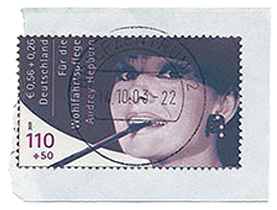Robert Murray Stamp Shop,
Edinburgh
KILOWARE - an explanation
Introduction.
"Kiloware" is the name given to stamps sold by weight,
normally still on the backing paper as they've been cut or
torn from envelopes. I don't know how far back the term
goes; certainly it was in use when I first became involved
with dealers and auctions and magazines about the early
1970s. An alternative name used then (but not often heard
now) was "mission mix". I've always had the impression
that this was originally from religious groups in Ireland
who collected stamps from the public and sold them -
sometimes directly to collectors - to raise funds. Another
term which has gone out of use is "bank mix" which would
be (as you might guess) stamps collected in a bank, so
that there were usually lots of higher values and neat
postmarks.
Almost always, the original source of kiloware is
charities. Buying kiloware has always been a popular way
for collectors to obtain stamps for their collections, for
various reasons (see "Advantages" below). For many new
collectors it would be their introduction to the hobby. In
recent years the hobby has gradually changed, as have the
ways in which stamps are traded, and the ways charities
work.
Over the years many charities - from small local to
massive global - have raised funds through collecting
kiloware and selling it on. Most charities would sell to
dealers, some would sell direct to collectors. Famously,
BBC's Blue Peter programme ran a scheme collecting
stamps for their Christmas appeal.
Illustration; A good quality world kiloware mix, well
trimmed and with good variety.
|

|
The
Advantages of Kiloware.
1. It's normally a low cost source of stamps for collectors. The
stamps should cost nothing to the charity *, and a dealer has
minimal work to do.
2. It's usually a good source of some of the more recent issues
commercially used. Many collectors prefer used stamps to mint,
and many of these prefer stamps that have actually been through
the post to ones which have been "cancelled-to-order".
3. There's the chance of good finds. Bear in mind that scarce
stamps scarcely turn up, and rare ones rarely ! It's not unusual
for collectors to find stamps worth a few pounds just now and
again - the possibility of coming up with a really stunning gem
is probably in line with the chances of a major lottery win.
4. In many cases the purchase of kiloware will support a charity
(either directly or through a trader).
5. It can be really quite enjoyable and therapeutic. Many people
find great enjoyment just sitting with a mixed bag of stamps,
sorting through to see what can be found. It can absorb your
attention for hours !
The Disadvantages of Kiloware.
1. Collectors buying kiloware will normally see diminishing
returns. So if a general world collector gets a general world
bag and finds a hundred stamps needed for their collection, a
second bag might give them ninety, and a third seventy, and so
on. Eventually they get to the point where it's not worth doing.
2. Charities can only sell on what they are given. If they get
donated good stuff, that's great for everybody, but sometimes
they'll be given bad stuff.
3. "Bad stuff" is most often what you might call "second time
around the block" stamps, where a collector has got themselves a
bagful, taken out everything they wanted for themselves,
anything they think their friends might like, or that they can
sell, and then donate the remainder back to a charity. That's
not a big problem if that one "bad stuff" bag gets amalgamated
with dozens of other better donations, but can otherwise lead to
dissatisfaction.
4. Another source of poorer mixes is where a charity is gleaning
the best out of what comes in. This is most often where they
have a philatelic volunteer who can recognise the stamps that
can be sold separately. That raises extra funds for the charity,
but the downside is that the mix they are left with is rather
lacklustre. This is not a common problem.
[If you happen to get a really poor mix from a charity or a
dealer, it is worth pointing this out. You shouldn't expect a
refund, as kiloware is accepted to be a bit of a gamble, but it
is useful for the seller to have the feedback.]
"Unsorted" vs. "Picked"
It is always best to be the first person to sort through a
batch of kiloware. That way, someone else will not have had a
chance to make the finds before you. However, as mentioned
above, there can be ways in which the kiloware can be picked
over before it gets to the charity, or to the dealer.
Most professional dealers do not pick over the kiloware they
sell. Consider this; if a collector spends an enjoyable evening
sorting through a big bag of stamps, and finds a few that they
consider to be worth a few pounds each, they'll think of that as
time well spent - but a dealer will not want to spend £10-worth
of their time hoping to find stamps worth £5.
The best approach, if you are in the habit of buying kiloware,
is probably to try different sources. But don't write one off
just because of one bad bag.
A Note Regarding the Present
State of Kiloware.
Things have changed in recent years. Going back a decade or
two, most of the stamps charities were given would be from
current or recent mail, but they would always have some that
people had from clearing out an old house, or going through
old family papers. They might therefore have gathered in a
year, say, 19kg of generally new mix plus 1kg of older, so the
mix looked like new stuff and was a good source of recent
stamps.
The current situation is that people actually get very few
stamps in the mail. Charities get smaller amounts handed in,
so the same charity might now be getting only 2kg of new mix,
but they are still getting the 1kg of older stamps, and the
mixture appears less appealing to the collector looking for
newer issues.
Almost everything we get now is like that, with a fair number
of older stamps included, and I'm afraid collectors will just
have to get used to it !
Self-Adhesives.
Many stamps found in modern kiloware are self-adhesive,
and very few of them can be floated or soaked off with water.
The best way of keeping these in a collection is simply to try
to trim the backing paper in a regular way, and mount or store
them as normal.
The "Elephant in the Room" !
The benign world of kiloware has always been tied up with
the murky world of unfranked stamps. There is a long history
of stamps not being postmarked, and of people taking them off
the envelope and using them again. In the UK, and similarly in
other countries, it is illegal to do so. The Post Office has
historically turned a blind eye to individuals doing this with
an odd stamp here and there, but sees high-volume re-use of
stamps as a threat to their revenue. Numerous people have been
taken to court and punished for the "industrial" re-use or
re-selling of unfranked stamps. See our longer article at this link.

|
A Kiloware
Tale of Rarities
In 2001 the German Post Office was set to
issue a stamp showing Audrey Hepburn. Before it was
issued her son objected to the image used being one
that had been altered to show her smoking, and would
not give permission. That stamp design was not issued,
but an unknown Deutsche Post employee "pocketed"
thirty sample examples of the stamp and used them to
send his own mail. So far only five of these have been
found, one selling in auction for €67,000. In theory,
another twenty-five might still be found . . . . and
some of these might still be in kiloware.
Image courtesy of Auktionshaus Ulrich Felzmann GmbH
& Co., Germany
|
Footnote.
* I've come across a couple of exceptions to this. In one case a
UK-wide charity offered to have kiloware picked up free from
members of the public, so they were having to pay carriage to
get stamps in. In another, a charity asked people to send in
their stamp donations by post, but some people would underpay
the postage and the charity had to pay the Post Office's
surcharge (therefore sometimes paying a couple of pounds to get
in stamps worth less than 50p).
Last updated Friday 4 October 2024.
 Click on the Penny Black to go
back to the beginning (our home page). | Click here to go to our site
contents page.
Click on the Penny Black to go
back to the beginning (our home page). | Click here to go to our site
contents page.
Any time you want
to find out more ..... send us an e-mail !
send us an e-mail !


